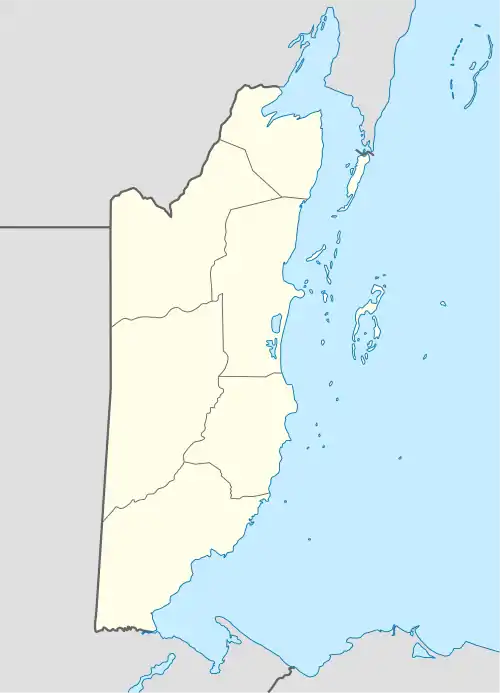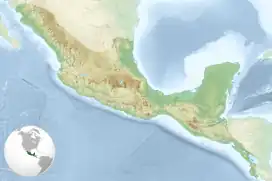 Longitudinal diagram of Tzibte Yux / excavation units 1–9 labelled / 2019 Prufer et al. / via PLOS ONE | |
 Tzibte Yux  Tzibte Yux | |
| Alternative name |
|
|---|---|
| Location | Rio Blanco National Park, Toledo, Belize |
| Region | Yucatan Peninsula |
| Coordinates | 16°13′45″N 89°05′36″W / 16.22918291312578°N 89.09335790400635°W |
| Type | Rock shelter |
| Length | 121 ft (37 m) |
| Width | 14.8 ft (4.5 m) |
| History | |
| Founded | 10500 BC |
| Abandoned | 6500 BC |
| Periods | Preceramic |
| Cultures | Palaeoindian |
| Site notes | |
| Discovered | 2009 |
| Excavation dates | 2012–2015 |
| Archaeologists | Keith Prufer / Uxbenka Archaeological Project |
| Ownership | Public |
| Management | Institute of Archaeology |
| Public access | Limited |
Tzibte Yux, Tzib Te Yux, or Tzib'te Yux, is a Preceramic rock shelter and archaeological site in the Rio Blanco National Park, Toledo, Belize. It is thought to have been occupied by Palaeoindian settlers during 10500 BC – 6500 BC.
Description
Tzibte Yux is a rockshelter measuring some 121 ft (37 m) long and 14.8 ft (4.5 m) wide at its widest point.[1] Its entrance, protected by a silicified limestone and conglomerate overhang, sits some 26 ft (8 m) above Blue Creek during the dry season, though this decreases to less than 6 ft (2 m) during the wet season.[1] Its floor is relatively flat and composed of sediments, predominantly jute snail shells deposited by former pre-Columbian inhabitants.[2]
Fishtail- and Lowe-style stemmed bifacial points have been recovered from Tzibte Yux, the former dated 10450 cal BC – 10085 cal BC, the latter 8275 cal BC – 6650 cal BC.[3][4] Human remains have also been recovered from the rock shelter.[2]
Study
Tzibte Yux was discovered by the Uxbenka Archaeological Project in 2009.[5] Subsequently, nine blocks or units, ie Units 1–9, covering some 194 sq ft (18 m2) of the rock shelter's floor, were excavated to a mean depth of some 2.5 ft (0.75 m) during 2012–2015.[6] A piece of charcoal found at the bottom of a red clay layer in Unit 1, some 23 in (58 cm) below the floor's surface, was dated to 10571 cal BC – 10526 cal BC. Most material in other units produced dates within 10500 cal BC – 6500 cal BC, though Unit 7 yielded a later date of 890 cal AD – 975 cal AD at 18.5 in (47 cm) below surface.[7]
Notes
- 1 2 Prufer et al. 2017, p. 322.
- 1 2 Prufer et al. 2017, p. 323.
- ↑ Braswell 2022, p. 90, fig. 4.5.
- ↑ Stemp et al. 2021, p. 419.
- ↑ Prufer et al. 2017, p. 321.
- ↑ Prufer et al. 2017, pp. 321–323.
- ↑ Prufer et al. 2017, pp. 323–325.
References
- Braswell, Geoffrey E., ed. (2022). 3,000 Years of War and Peace in the Maya Lowlands: Identity, Politics, and Violence. London: Routledge. doi:10.4324/9781351268004. ISBN 9781351268004. S2CID 246542762.
- Dennehy, Timothy J. (2021). From Foragers to Farmers in Tropical Forests: How Paleoindian and Archaic Peoples in Southern Belize Adapted Their Lithics, Mobility, and Subsistence to a Changing Holocene Climate (PhD thesis). Arizona State University. ProQuest 2610379260.
- Houk, Brett A.; Arroyo, Barbara; Powis, Terry G., eds. (2019). Approaches to Monumental Landscapes of the Ancient Maya: A Legacy of Human Occupation. Maya studies. Gainesville, Fl.: University Press of Florida. ISBN 9780813057347. OCLC 1137019195.
- Lohse, Jon C. (13 January 2020). "Early Holocene Cultural Diversity in Central America: Comment on Prufer et al. (2019) "Linking Late Paleoindian Stone Tool Technologies and Populations in North, Central and South America"". Lithic Technology. 45 (2): 59–67. doi:10.1080/01977261.2020.1713609. S2CID 245125311.
- Meredith, Clayton (2014). Analysis of Small Cave Sites Related to the Uxbenka Polity: Application of FT-IR Techniques in the Study of Ritual Practice (MA thesis). Idaho State University.
- Prufer, Keith M. (1 August 2018). "Preceramic Cultural History in Southern Belize and its Environmental Context". Research Reports in Belizean Archaeology. 15: 241–251. ISSN 2079-1038.
- Prufer, Keith M.; Alsgaard, Asia V.; Robinson, Mark; Meredith, Clayton R.; Culleton, Brendan J.; Dennehy, Timothy; Magee, Shelby; Huckell, Bruce B.; Stemp, W. James; Awe, Jaime J.; Capriles, Jose M.; Kennett, Douglas J. (18 July 2019). "Linking late paleoindian stone tool technologies and populations in North, Central and South America". PLOS ONE. 14 (7): 1-20 of article no. e0219812. Bibcode:2019PLoSO..1419812P. doi:10.1371/journal.pone.0219812. PMC 6638942. PMID 31318917.
- Prufer, Keith M.; Meredith, Clayton R.; Alsgaard, Asia V.; Dennehy, Timothy; Kennett, Douglas (1 January 2017). "The Paleoindian Chronology of Tzib Te Yux Rockshelter in the Rio Blanco Valley of Southern Belize". Research Reports in Belizean Archaeology. 14: 321–326. ISSN 2079-1038.
- Prufer, Keith M.; Robinson, Mark; Kennett, Douglas J. (14 December 2021). "Terminal Pleistocene Through Middle Holocene Occupations in Southeastern Mesoamerica: Linking Ecology and Culture in the Context of Neotropical Foragers and Early Farmers". Ancient Mesoamerica. 32 (3): 439–460. doi:10.1017/S0956536121000195. S2CID 245125309.
- Stemp, W. James; Awe, Jaime J.; Marcus, Joyce; Helmke, Christophe; Sullivan, Lauren A. (14 December 2021). "The Preceramic and Early Ceramic Periods in Belize and the Central Maya Lowlands". Ancient Mesoamerica. 32 (3): 416–438. doi:10.1017/S0956536121000444. S2CID 245125311.